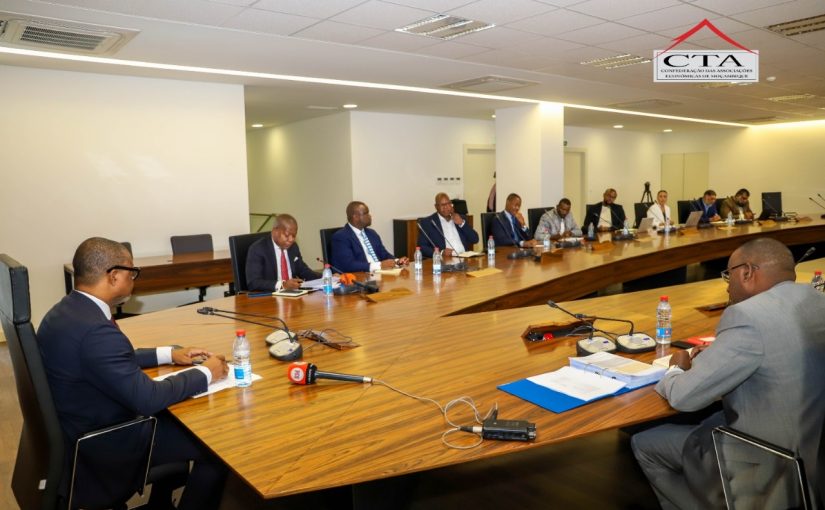Mozambique: Government has 180 days to decide on concession of N4 to TRAC
Mozambique: Government and private sector analyse tax measures within the PAE framework – CTA

The private sector's analysis of the Mozambican tax system that the CTA has submitted to the Ministry of Economy and Finance show that the current tax burden on domestic companies is 36.1%, above that of most developing countries. This level is very close to the maximum point of the Laffer curve, which is 36.67%. [Photo courtesy: CTA]
The Minister of Economy and Finance has met representatives of Mozambique’s private sector to analyse tax measures advanced within the scope of the Economic Acceleration Stimulus Package (PAE) announced by the government.
The President of the Confederation of Business Associations of Mozambique, Agostinho Vuma, began by congratulating the government on the recent measures, which he said exemplified a new approach which sought to reduce the tax burden.
Reduction of the tax burden and consolidation of the municipal tax subsystem
The private sector’s analysis of the national tax system, which CTA has submitted to the Ministry of Economy and Finance, puts the current tax burden on Mozambican companies at 36.1% – above the tax burden of most developing countries. This level of tax burden is very close to the maximum point of the Laffer curve (36.67%), beyond which any increase in rates and taxes on companies will have a negative effect on the volume of public revenue.
The approach of the tax burden to this point is due, in part, to the current structure of the tax system, which tends to federalise Mozambican tax policy. This is because each sector or ministry has the prerogative to administer tax rates or charges to address sectoral problems without necessarily going through an analysis of the tax burden already borne by companies. This scenario makes tax policy more complex and difficult to control, which ends up negatively influencing the performance of the private sector.
The private sector therefore recommends that the tax system be reviewed so that the prudential limits of Small and Medium Enterprises are not exceeded.
As a first intervention, the CTA proposed that the Ministry of Economy and Finance take charge of evaluating the general panorama of taxation on companies and for monitoring prudently the tax burden consequences of each tax and/or fee that is intended to be introduced. To this end, it would be necessary for tax policy to be centralised in the Ministry of Economy and Finance, eliminating or reducing the prerogative of sectoral entities to administer autonomous taxation processes for the mobilisation of revenues.
The leadership of the Ministry of Economy and Finance might also include the unification of the municipal tax subsystems of the same nature and objectives, with adequate revenue sharing between the different levels of government. This would lead to the administrative integration, systematisation and unification, in the short term, of tax procedures currently multiple and dispersed between central and municipal levels, in the scope of the registration, licensing, assessment, payment and inspection of the various types of taxes, fees and licences due from small economic operators.
See the study on the optimization of fiscal policy, in Portuguese, HERE.
The reduction of VAT and IRPC
Regarding the recent PAE cut in VAT from 17% to 16%, the private sector advocates that same reduction be made in VAT on electricity and water.
It further proposes the creation of mechanisms for offsetting tax debts, as a way of avoiding the delays in VAT refunds which have affected the cash flow of many companies over the last few years.
Still on the PAE, the private sector professed itself pleased with the reduction of the Corporate Income Tax (IRPC) for the agriculture sector from 32% to 10%, a measure it had long been asking for.
However, it stresses the need for the concept of ‘agriculture’ to be extended to the entire agrarian sector.
Additionally, incentives in the road transport sector should be extended to interprovincial and inter-district road freight transport.
The private sector also suggests exempting urban passenger transporters from the IRPC, with a view to attracting greater formalisation in this sector.
Tax incentives for new investments in key sectors
On fiscal incentives for new investments in key sectors over the next three years, the private sector proposes, first of all, the extension of these incentives to investments already implemented in geographical areas affected by cyclones and the insurgency.
Highlighted concerns
Despite the measures adopted by the government, there are still tax reforms which the business sector would like to see, and which the president of the CTA highlighted.
These include:
- The need to review the Corporate Income Tax (IRPC) and Personal Income Tax (IRPS) rates for all sectors of activity;
- VAT exemption effective for all transfers of agricultural products;
- The revision of the Specific Consumption Tax, which expires this year, regarding which the private sector has not yet seen any proposal;
- Reduction of tax withholding in the agriculture sector from 20% to 10%;
- A review of the Customs Tariff as a mechanism for applying tax incentives to local agro-industries which use locally acquired raw materials, as well as to serve as a mechanism for the development of the industry nationally.
















Leave a Reply
Be the First to Comment!
You must be logged in to post a comment.
You must be logged in to post a comment.